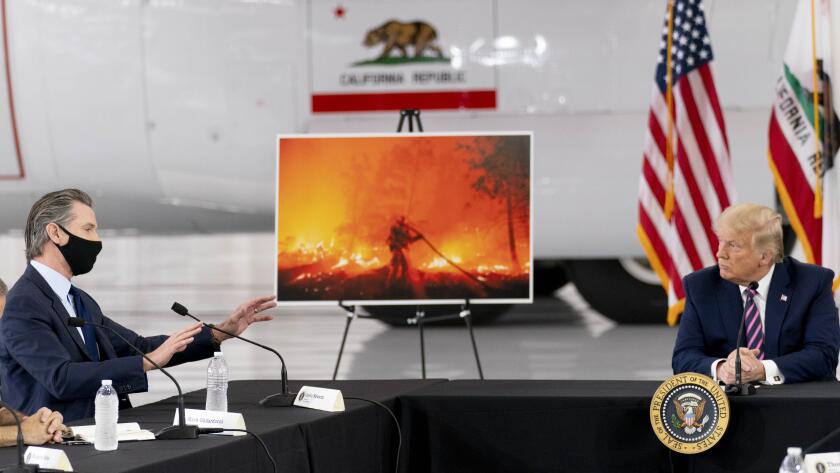Trump’s antagonistic relationship with California overshadows his visit to check on wildfires
- Share via
At Sacramento McClellan Airport in McClellan Park on Monday, Gov. Gavin Newsom, left, and President Trump were briefed on the wildfires burning in California.
- Share via
McCLELLAN PARK, Calif. — President Trump arrived in Northern California on Monday for a briefing on the deadly wildfires, an event overshadowed by his long-standing tensions with state officials and refusal to acknowledge the role of climate change in the blazes.
Gov. Gavin Newsom did not greet the president on the airfield when Air Force One landed shortly before 11 a.m. at McClellan Park, just outside Sacramento.
Trump’s noon meeting with Newsom and top state and federal emergency management and environmental officials kept a respectful tone. But a discussion of climate change’s impact on wildfires again found the president and state officials at loggerheads over the issue.
In a contentious exchange, Wade Crowfoot, Newsom’s secretary for natural resources, told Trump that America must accept the realities of climate change.
“If we ignore that science and sort of put our head in the sand and think it’s all about vegetation management, we’re not going to succeed together protecting Californians,” said Crowfoot, who was joined at the meeting by other California emergency officials including Thom Porter, director of the California Department of Forestry and Fire Protection, and Mark Ghilarducci, director of the California Governor’s Office of Emergency Services.
“OK,” Trump replied. “It’ll start getting cooler. You just watch.”
“I wish science agreed with you,” Crowfoot said before Trump responded, refusing to yield: “I don’t think science knows, actually.”
Newsom later emphasized that scientific evidence showed a clear link between climate change and California’s catastrophic wildfires that have killed at least 24 people in the last month. But the governor, who has long said that when it comes to the pandemic and wildfires, his primary concern is caring for the well-being of Californians and not inflaming a political battle with Trump, struck a more conciliatory tone.
“We’ve known each other too long, and the working relationship I value. I think there’s an area of at least commonality with respect on vegetation and forest management,” Newsom told the president during the noon briefing with top state and federal emergency management and environmental officials. “But please respect, and I know you do, to the difference of opinion out here as it relates to this fundamental issue of climate change.”
Sierra Club California Director Kathryn Phillips said Newsom was wise to keep the meeting with Trump cordial.
“This is not a stable person that he’s dealing with. I think he struck the tone with this particular individual that he had to strike in order to ensure that he would continue to be able to get resources for California for the greater good,” Phillips said. “It’s kind of like dancing with a rattlesnake.”
Before his meeting with Newsom, Trump doubled down on his criticism that poor forest management has caused California’s wildfires.
“Forest management is not only the leaves that have been sitting there for many years that are dry as a bone, but there’s also trees that go over,” he said in brief remarks with reporters after stepping off of Air Force One. “Management is very important.”
He cited northern European forests — which grow in a much wetter and less fire-prone environment than California — as examples of how forest management prevented fires even though those countries have “more explosive trees.”
“If you look at other countries in Europe — Austria, Finland and numerous countries. They’re forest nations. They don’t have problems. They have very explosive trees.”
And in an apparent reference to fuel breaks — of which California has hundreds, if not thousands of miles — Trump said: “They also have to do cuts — 50-yard cuts so that if you have a section that goes, it’s not going to take the whole 100,000 acres.”
But Trump’s comments ignore that much of the more than 3 million acres that have burned in California this year are not forest lands, but shrublands, grasslands and oak woodlands. Moreover, most of California forests are owned by the federal government and managed by the U.S. Forest Service, whose historic policies set the stage for more intense fires in Sierra Nevada.
The agency logged big, fire resistant trees. And it suppressed the frequent, low-intensity burns that acted as nature’s housekeeper in the mid-elevation pine belt, promoting dense, young growth that serves as more fuel.
Still, Trump said the federal government is working with the state on forest management and repeatedly mentioned how quickly he declared a major disaster due to the wildfires in August after speaking on the phone with Newsom.
“We’re obviously from different sides of the spectrum, but we have a very good relationship,” Trump said.
Ahead of the president’s arrival, a group of protesters holding anti-Trump signs and more than 100 people carrying Trump 2020 signs and waving American flags gathered outside McClellan Airfield.
Two protesters sustained minor injuries when they were struck by a car in an apparent hit-and-run, though they did not require hospitalization, California Highway Patrol spokesman Officer A.J. McTaggart said. According to social media posts, other protesters may have sustained injuries after climbing on top of a CHP patrol car and falling off. Both incidents are under investigation, McTaggart said.
Federal Emergency Management Agency Administrator Pete Gaynor, acting Homeland Security Secretary Chad Wolf and others accompanied Trump on the trip.
His brief two-hour visit came following criticism that he was too slow to acknowledge the blazes up and down the West Coast as he campaigns in the run-up to the November election.
In California, wildfires have burned more than 3.3 million acres this year — an area of land that Cal Fire says is larger than the state of Connecticut. More than 4,100 structures have been destroyed since lightning strikes first ignited a series of fires in mid-August.
Late last week, the president tweeted his support for firefighters and first responders and on Monday awarded Distinguished Flying Cross medals to seven members of the California Army National Guard who helped rescue dozens of stranded hikers and campers from the Creek fire in Sierra Nevada.
“Our nation is strong because of remarkable individuals like these service members,” Trump said in a ceremony inside an aircraft hangar at McClellan Airfield. “America prevails because of the brave and selfless patriots who risk everything so that they may save lives of people, in many cases that they don’t know.”
The trip also marks another chapter in the complicated relationship between Trump and Newsom, who stoke their polar-opposite bases of support with occasional spars on social media or in the press, but talk on the phone frequently and appear almost congenial in person.
Though the president toured the destruction wrought by the 2018 Camp fire in the town of Paradise alongside then Gov.-elect Newsom and former Gov. Jerry Brown, Trump and Newsom did not tour wildfire sites together on Monday.
At a campaign rally shortly after the wildfires began last month, Trump blamed state officials for the blazes, again repeating his criticism that California needs to clean up fallen leaves and other natural debris on forest floors. He also threatened to withhold federal funding, a warning he often issues on social media.
In response, Newsom has reiterated the fact that the federal government owns nearly 58% of California’s 33 million acres of forestlands, compared with the 3% owned by the state. The remainder is owned by private landholders, local governments and others.
Newsom, a supporter of Democratic presidential nominee Joe Biden, has in the past mocked Trump for his comments about cleaning up dead leaves and other flammable debris on the forest floors. He also criticized the president over allegations that Trump wanted to withhold disaster relief money for California’s wildfires after the 2018 Camp fire because voters in the state opposed him politically.
“The president of the United States threatened the state of California, 40 million Americans who happen to live here in the state of California, to defund our efforts on wildfire suppression because he said we hadn’t raked enough leaves. You can’t make that up,” Newsom said in August. “There’s so much at stake in this election.”
Despite Trump’s threats and affinity for excoriating California, where he finished 4 million votes behind Hillary Clinton in the 2016 presidential election, his administration did not withhold the funding.
Meanwhile, the governor has noticeably refrained from publicly jabbing Trump on his response to the pandemic in California. For months, Newsom has said that the Trump administration has responded each time California has asked for assistance.
“There’s not one phone call that I have made to the president where he hasn’t quickly responded, and almost in every instance, he’s responded favorably in terms of addressing the needs, the emergency needs of the state,” Newsom said just a few weeks ago. “Over the course of at least a year and a half that I’ve been governor, as it relates to these wildfires, he may make statements publicly, but the working relationship privately has been a very effective one.”
In late March, Newsom lauded Trump for dispatching the Navy hospital ship Mercy to the Port of Los Angeles to help free up capacity in Southern California hospitals for those stricken with COVID-19. He has also credited Trump for sending mobile military medical units.
Newsom again praised the president in April after the federal government sent California coronavirus testing supplies, saying “promise made, promise kept,” a mainstay slogan for the Trump campaign. Newsom’s comment was not well received by Democrats — and it quickly appeared in a Trump reelection video touting the president’s response to the pandemic.
But Newsom has also highlighted California’s position at the forefront of battling against the Trump administration’s policies on the environment, immigration and healthcare. California has sued the Trump administration more than 100 times, often successfully, on a variety of issues, including more than two dozen challenges to policies proposed by the Environmental Protection Agency, the Department of the Interior and other federal agencies responsible for setting energy and fuel-efficiency standards.
“We’re involved in dozens and dozens of lawsuits against an administration that doesn’t see eye to eye with us,” Newsom said Friday. “Rather than lamenting about it, we’ll continue to fight in the courts, will continue to win, as we are overwhelmingly against the rollbacks of the Clean Air Act and the Clean Water Act.”
Newsom took a shot at the Trump administration last week for failing to fight climate change, but he also praised the president at the same news conference for proactively declaring emergencies and approving federal grants for state and local governments to mitigate, manage and control fires.
Trump approved Newsom’s request for a presidential major disaster declaration in California on Aug. 22 due to wildfires. The move, which came two days after Trump blamed the state for the fires at his presidential campaign rally, allows local and state governments to seek federal funds for emergency response and recovery efforts.
California and the U.S. Forest Service also reached an agreement late last month in which the federal government will match the state’s goal of decreasing the fire risks on 500,000 acres of forest land per year by 2025.
Times staff writer Bettina Boxall contributed to this report.
More to Read
Sign up for Essential California
The most important California stories and recommendations in your inbox every morning.
You may occasionally receive promotional content from the Los Angeles Times.
















